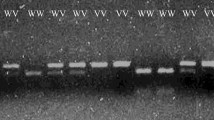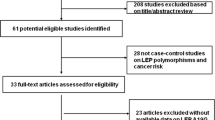Abstract
Obesity is a strong risk factor for breast cancer in postmenopausal women and adverse prognostic indicator regardless of menopausal status. Leptin is an important regulator of adipose tissue mass and has been associated with tumor cell growth. Leptin exerts its effects through interaction with the leptin receptor (LEPR). We investigated whether genetic variations in the leptin (LEP) and LEPR genes are associated with risk of breast cancer, or once diagnosed, with survival. The polymorphisms LEP G-2548A and LEPR Q223R were characterized in population-based study consisting of mostly European-American women. The study examined 1,065 women diagnosed with first, primary invasive breast cancer between 1996 and 1997. Controls were 1,108 women frequency matched to the cases by 5-year age group. A modest increase in risk of developing breast cancer was associated with the LEP −2548AA genotype when compared to the LEP −2548GG genotype (age-adjusted OR = 1.30; 95% CI = 1.01–1.66). This association was stronger among postmenopausal women who were obese (OR = 1.86; 95% CI = 0.95–3.64) although the interaction was of borderline statistical significance (P = 0.07). We found no evidence of an association with polymorphisms of either LEP or LEPR in relation to all-cause or breast cancer-specific mortality among women with breast cancer (mean follow-up time = 66.7 months). The effects of these genotypes on breast cancer risk and mortality did not vary significantly when stratified by menopausal status. In summary, our results show that a common variant in LEP may be associated with the risk of developing breast cancer supporting the hypothesis that leptin is involved in breast carcinogenesis.
Similar content being viewed by others
References
World Health Organization (WHO) (2000) Obesity: preventing and managing the global epidemic. Report of a WHO consultation. World Health Organ Tech Rep Ser 894 (i–xii): 1–253
Stephenson GD, Rose DP (2003) Breast cancer and obesity: an update. Nutr Cancer 45:1–16
Loi S, Milne RL, Friedlander ML, McCredie MR, Giles GG, Hopper JL, Phillips KA (2005) Obesity and outcomes in premenopausal and postmenopausal breast cancer. Cancer Epidemiol Biomarkers Prev 14:1686–1691
Lamar CA, Dorgan JF, Longcope C, Stanczyk FZ, Falk RT, Stephenson HE Jr (2003) Serum sex hormones and breast cancer risk factors in postmenopausal women. Cancer Epidemiol Biomarkers Prev 12:380–383
Schwartz MW, Baskin DG, Kaiyala KJ, Woods SC (1999) Model for the regulation of energy balance and adiposity by the central nervous system. Am J Clin Nutr 69:584–596
Zhang Y, Proenca R, Maffei M, Barone M, Leopold L, Friedman JM (1994) Positional cloning of the mouse obese gene and its human homologue. Nature 372:425–432
Hamilton BS, Paglia D, Kwan AY, Deitel M (1995) Increased obese mRNA expression in omental fat cells from massively obese humans. Nat Med 1:953–956
Baratta M (2002) Leptin—from a signal of adiposity to a hormonal mediator in peripheral tissues. Med Sci Monit 8: RA282–RA292
Rose DP, Gilhooly EM, Nixon DW (2002) Adverse effects of obesity on breast cancer prognosis, and the biological actions of leptin (review). Int J Oncol 21:1285–1292
Gonzalez RR, Cherfils S, Escobar M, Yoo JH, Carino C, Styer AK, Sullivan BT, Sakamoto H, Olawaiye A, Serikawa T, Lynch MP, Rueda BR (2006) Leptin signaling promotes the growth of mammary tumors and increases the expression of vascular endothelial growth factor (VEGF) and its receptor type two (VEGF-R2). J Biol Chem 281:26320–26328
Dieudonne MN, Sammari A, Dos Santos E, Leneveu MC, Giudicelli Y, Pecquery R (2006) Sex steroids and leptin regulate 11beta-hydroxysteroid dehydrogenase I and P450 aromatase expressions in human preadipocytes: Sex specificities. J Steroid Biochem Mol Biol 99:189–196
Huang L, Li C (2000) Leptin: a multifunctional hormone. Cell Res 10:81–92
Falk RT, Brinton LA, Madigan MP, Potischman N, Sturgeon SR, Malone KE, Daling JR (2006) Interrelationships between serum leptin, IGF-1, IGFBP3, C-peptide and prolactin and breast cancer risk in young women. Breast Cancer Res Treat 98:157–165
Petridou E, Papadiamantis Y, Markopoulos C, Spanos E, Dessypris N, Trichopoulos D (2000) Leptin and insulin growth factor I in relation to breast cancer (Greece). Cancer Causes Control 11:383–388
Stattin P, Soderberg S, Biessy C, Lenner P, Hallmans G, Kaaks R, Olsson T (2004) Plasma leptin and breast cancer risk: a prospective study in northern Sweden. Breast Cancer Res Treat 86:191–196
Coleman DL (1978) Obese and diabetes: two mutant genes causing diabetes-obesity syndromes in mice. Diabetologia 14:141–148
Friedman JM, Leibel RL, Siegel DS, Walsh J, Bahary N (1991) Molecular mapping of the mouse ob mutation. Genomics 11:1054–1062
Chagnon YC, Wilmore JH, Borecki IB, Gagnon J, Perusse L, Chagnon M, Collier GR, Leon AS, Skinner JS, Rao DC, Bouchard C (2000) Associations between the leptin receptor gene and adiposity in middle-aged Caucasian males from the HERITAGE family study. J Clin Endocrinol Metab 85:29–34
Mammes O, Betoulle D, Aubert R, Herbeth B, Siest G, Fumeron F (2000) Association of the G-2548A polymorphism in the 5’ region of the LEP gene with overweight. Ann Hum Genet 64:391–394
Yiannakouris N, Yannakoulia M, Melistas L, Chan JL, Klimis-Zacas D, Mantzoros CS (2001) The Q223R polymorphism of the leptin receptor gene is significantly associated with obesity and predicts a small percentage of body weight and body composition variability. J Clin Endocrinol Metab 86:4434–4439
Hoffstedt J, Eriksson P, Mottagui-Tabar S, Arner P (2002) A polymorphism in the leptin promoter region (−2548 G/A) influences gene expression and adipose tissue secretion of leptin. Horm Metab Res 34:355–359
Gammon MD, Neugut AI, Santella RM, Teitelbaum SL, Britton JA, Terry MB, Eng SM, Wolff MS, Stellman SD, Kabat GC, Levin B, Bradlow HL, Hatch M, Beyea J, Camann D, Trent M, Senie RT, Garbowski GC, Maffeo C, Montalvan P, Berkowitz GS, Kemeny M, Citron M, Schnabe F, Schuss A, Hajdu S, Vincguerra V, Collman GW, Obrams GI (2002) The Long Island Breast Cancer Study Project: description of a multi-institutional collaboration to identify environmental risk factors for breast cancer. Breast Cancer Res Treat 74:235–254
Waksberg J (1978) Sampling methods for random digit dialing. J Am Stat Assoc 73:40–46
Ribeiro R, Araujo AP, Coelho A, Catarino R, Pinto D, Araujo A, Calcada C, Lopes C, Medeiros R (2006) A functional polymorphism in the promoter region of leptin gene increases susceptibility for non-small cell lung cancer. Eur J Cancer 42:1188–1193
Ross JA, Oeffinger KC, Davies SM, Mertens AC, Langer EK, Kiffmeyer WR, Sklar CA, Stovall M, Yasui Y, Robison LL (2004) Genetic variation in the leptin receptor gene and obesity in survivors of childhood acute lymphoblastic leukemia: a report from the Childhood Cancer Survivor Study. J Clin Oncol 22:3558–3562
Willett EV, Skibola CF, Adamson P, Skibola DR, Morgan GJ, Smith MT, Roman E (2005) Non-Hodgkin’s lymphoma, obesity and energy homeostasis polymorphisms. Br J Cancer 93:811–816
Hosmer D, Lemeshow S (1989) Applied logistic regression. John Wiley, New York
Allison P (1995) Survival analysis using SAS: a practical guide. SAS, Cary
World Health Organization (WHO) (1995) Report of a WHO expert committee. Physical status: the use and interpretation of anthropometry. WHO, Geneva
Goodwin PJ, Ennis M, Fantus IG, Pritchard KI, Trudeau ME, Koo J, Hood N (2005) Is leptin a mediator of adverse prognostic effects of obesity in breast cancer? J Clin Oncol 23:6037–6042
Ishikawa M, Kitayama J, Nagawa H (2004) Enhanced expression of leptin and leptin receptor (OB-R) in human breast cancer. Clin Cancer Res 10:4325–4331
Miyoshi Y, Funahashi T, Tanaka S, Taguchi T, Tamaki Y, Shimomura I, Noguchi S (2006) High expression of leptin receptor mRNA in breast cancer tissue predicts poor prognosis for patients with high, but not low, serum leptin levels. Int J Cancer 118:1414–1419
Snoussi K, Strosberg AD, Bouaouina N, Ben Ahmed S, Helal AN, Chouchane L (2006) Leptin and leptin receptor polymorphisms are associated with increased risk and poor prognosis of breast carcinoma. BMC Cancer 6:38
Ribeiro R, Vasconcelos A, Costa S, Pinto D, Morais A, Oliveira J, Lobo F, Lopes C, Medeiros R (2004) Overexpressing leptin genetic polymorphism (−2548 G/A) is associated with susceptibility to prostate cancer and risk of advanced disease. Prostate 59:268–274
Skibola CF, Holly EA, Forrest MS, Hubbard A, Bracci PM, Skibola DR, Hegedus C, Smith MT (2004) Body mass index, leptin and leptin receptor polymorphisms, and non-hodgkin lymphoma. Cancer Epidemiol Biomarkers Prev 13:779–786
Hu X, Juneja SC, Maihle NJ, Cleary MP (2002) Leptin–a growth factor in normal and malignant breast cells and for normal mammary gland development. J Natl Cancer Inst 94:1704–1711
Mantzoros CS, Bolhke K, Moschos S, Cramer DW (1999) Leptin in relation to carcinoma in situ of the breast: a study of pre-menopausal cases and controls. Int J Cancer 80:523–526
Woo HY, Park H, Ki CS, Park YL, Bae WG (2006) Relationships among serum leptin, leptin receptor gene polymorphisms, and breast cancer in Korea. Cancer Lett 237:137–142
Ogawa T, Hirose H, Yamamoto Y, Nishikai K, Miyashita K, Nakamura H, Saito I, Saruta T (2004) Relationships between serum soluble leptin receptor level and serum leptin and adiponectin levels, insulin resistance index, lipid profile, and leptin receptor gene polymorphisms in the Japanese population. Metabolism 53:879–885
Roth MJ, Paltoo DN, Albert PS, Baer DJ, Judd JT, Tangrea J, Taylor PR (2005) Common leptin receptor polymorphisms do not modify the effect of alcohol ingestion on serum leptin levels in a controlled feeding and alcohol ingestion study. Cancer Epidemiol Biomarkers Prev 14:1576–1578
Paracchini V, Pedotti P, Taioli E (2005) Genetics of leptin and obesity: a HuGE review. Am J Epidemiol 162:101–114
Chlebowski RT, Aiello E, McTiernan A (2002) Weight loss in breast cancer patient management. J Clin Oncol 20:1128–1143
Cleveland RJ, Eng SM, Abrahamson PE, Britton JA, Teitelbaum SL, Neugut AI, Gammon MD (2007) Weight gain prior to breast cancer diagnosis and survival. Cancer Epidemiol Biomarkers Prev (in press)
Eng SM, Gammon MD, Terry MB, Kushi LH, Teitelbaum SL, Britton JA, Neugut AI (2005) Body size changes in relation to postmenopausal breast cancer among women on Long Island, New York. Am J Epidemiol 162:229–237
Gomez JM, Maravall FJ, Gomez N, Navarro MA, Casamitjana R, Soler J (2003) Interactions between serum leptin, the insulin-like growth factor-I system, and sex, age, anthropometric and body composition variables in a healthy population randomly selected. Clin Endocrinol (Oxf) 58:213–219
Acknowledgments
For their valuable contributions, the authors thank: members of the Long Island Breast Cancer Network; the participating institutions; our NIH and NIEHS collaborators; members of the External Advisory Committee to the population-based case–control study. We also wish to acknowledge and thank the following LIBCSP collaborators for their contributions with various aspects of our study efforts including: Amanda Golembesky, Ph.D. and Julie Britton, Ph.D. This work is supported by the University of North Carolina Nutrition and Cancer Training grant NCI T32CA72319; National Cancer Institute and the National Institutes of Environmental Health and Sciences grant nos. UO1CA/ES66572, UO1CA66572, P50CA52283, P30ES09089, P30ES10126, and 5T32CA009330-25; and the Breast Cancer Research Fund.
Author information
Authors and Affiliations
Corresponding author
Rights and permissions
About this article
Cite this article
Cleveland, R.J., Gammon, M.D., Long, CM. et al. Common genetic variations in the LEP and LEPR genes, obesity and breast cancer incidence and survival. Breast Cancer Res Treat 120, 745–752 (2010). https://doi.org/10.1007/s10549-009-0503-1
Received:
Accepted:
Published:
Issue Date:
DOI: https://doi.org/10.1007/s10549-009-0503-1




